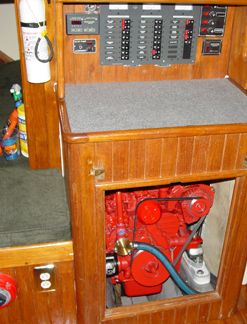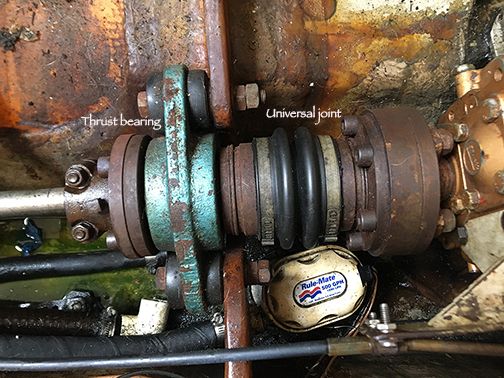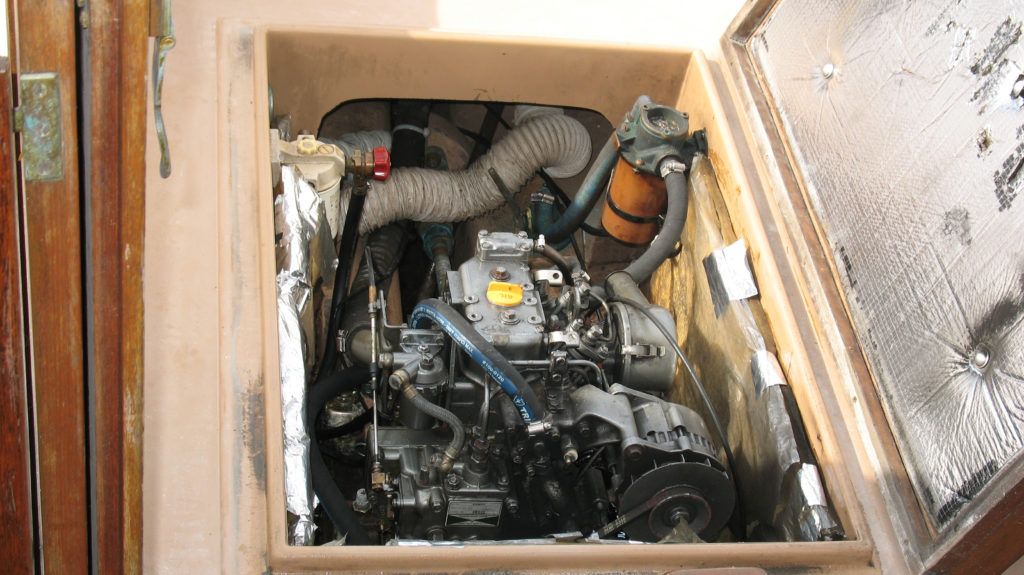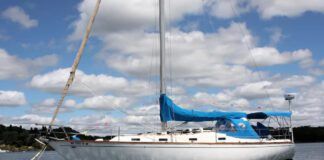Of all the health reporting that has been featured in the news recently, the theme of ambient noise is one that resonated strongly with me (pun intended). According to the reports, people are spending more time at home–or on their boats–and have become more aware of the ambient noise that fills the spaces where they live and work (which for many of us is now one and the same).
Some office workers can’t seem to get comfortable working at home without the thrum of activity. Others, like me, are suddenly becoming aware of how the noises of our lives and livelihoods have taken a toll on our hearing. I don’t know if it is something in the air, but three readers contacted me this week regarding noise control on their sailboats.
One reader asked about ways to dampen the slap of water on a counter stern, a rare problem, but one I’ve heard of before. The other two readers faced a more common problem—engine noise. In either case, the noise can be much more than just an inconvenience.
The long-ranging impacts of daily noise are explored in a wonderfully disturbing book by David Owen ” Volume Control: Hearing In A Deafening World.” The most important lesson I learned from Owen’s book and from other similar investigations is that the noise regarded as offensive can vary greatly between individuals.
A relatively young field of health research in hyperacusis — extreme sensitivity — explores why some frequencies and pitches are actually quite painful for some individuals. As researchers are discovering, some noises may actually be quite personal — associated with traumatic events of our past — which is why they impact us in ways that they don’t seem to impact others in our circle.
So, if your sailing partner complains about a noise that doesn’t really bother you, it might not necessarily something that they can just “get used to.” You will have to address it through active sound reduction measures.
The good thing about sailing is that for most of us, the ambient sounds of water are actually quite soothing. While we’ve not explicitly looked at ways to reduce splashing noises, we have explored the various materials used to insulate our boats and engine rooms, including a test of 10 different boat noise insulation products.
Many of the manufacturers in that test are still active today, and the products are relatively unchanged despite the passage of time, and one of the most prominent players in our last test, Soundown, is still regarded as a leader in the field.
A little more recently, we’ve also tested noise insulating paint, and in 2017 we looked at below-the-waterline hull insulation products that will also help with sound dampening. Another important source of onboard noise is engine and drive-train vibration, something that high-latitude adventurer Andy O’Grady explored in the Cruising Sailor’s Drive Train. Although we’ve not compared flexible couplings like the popular Drive Saver, we have reported on it generally in field reports and in a Practical Sailor Advisor question about flexible couplings.
For those who are exploring way to silence your engine, I’ll reiterate some points here from our previous reports, including a Practical Sailor Advisor article on building an insulated engine box.

Engine noise
Engines make noise. Crew – especially when they’re trying to hold a conversation, sleep, or just relax – don’t like noise. The solution? Isolate the crew from the engine noise and vibration.
Noise and vibration are inseparable. Noise exists because vibration causes variations in the air pressure that reaches the ear. This is perceived as sound. An effective control deals with both the vibration and the airborne noise.
Measuring Noise
Noise levels are measured in decibel units, usually referred to as dBA (the A denoting that the measurement is adjusted for the frequency response of the human ear, rather than the total sound level energy). Everyday sounds fall into a range from roughly 25 dBA (a suburban bedroom at night) to 100 dBA (a chainsaw at a distance of 3 feet).
A sensitive ear can distinguish differences of 1 dBA, but it takes a 5-dBA difference to be noticeable. On a boat, an unshielded diesel genset will produce sound levels of 100 dBA at 3 feet; an inboard typically raises the noise in the engine room to about 110 dBA. The object is to drop those levels to approximately 75 dBA for more-or-less normal conversation, and another 20 dBA for comfortable sleeping with the engine running.
There are three basic approaches to making your boat quieter. The first step is to use flexible mounts to isolate the vibrating machinery from the hull. These help prevent the transmission of vibration through the solid structure of the boat, and the consequent reverberation of hull sections that can act like amplifiers. Correcting any engine-shaft misalignment will certainly help.
The next step is to surround the noise-producing machinery in a tight, insulated enclosure to reduce air-transmitted noise.
The final step is to line enclosed living quarters, such as cabins, with sound-absorbent materials.
Vibration Noise
Once you’ve reduced vibration and the associated structure-transmitted noise, you’re ready to deal with airborne noise. The first step is to enclose the noise-generating components-the engine-in some sort of box or compartment. Almost any sort of enclosure will reduce noise levels by 5 to 10 dBA, but improving on that takes an understanding of the nature of noise.

The 5-10 dBA reduction that comes from putting the engine in a box is due almost entirely to the sound energy absorbed by the box; most of the noise is transmitted right through the box’s walls. Reflection may have some value in some situations, but reflecting sound waves back into an enclosure simply makes it noisier inside the enclosure. A reflective material works when there’s somewhere to reflect the sound.
Sound, after all, is a form of energy, and you can’t just make it vanish. You can, however, convert sound energy into another form of energy-heat. The energy dissipates when the absorbent material becomes displaced or compressed.
Energy Absorbing Materials
The amount of energy absorbed depends upon the mass (or weight) of the material, how far its displaced or compressed, and the material’s damping capability. Materials like lightweight foams and fiberglass wool have good damping but not enough mass to be effective by themselves. They have a role in dealing with noise, insofar as they can reduce reflection. More specialized sound-absorbers are more effective. These are composite materials with a high-mass layer, one or more damping layers, and (usually) a thin plastic film at each face to protect the damping layer(s) from mechanical damage and moisture.

The high-mass layer should be heavy, limp, and nonporous. It should also be as thin as possible, simply because space aboard is usually at a premium. A sheet of lead works best, but a lead-filled sheet of plastic can be used where a physically tougher material is required. Mass layers of lead typically weigh 1-2 lbs. per square foot; lead-filled plastic weighs about half that for an equivalent thickness.
On either side of the mass layer is a layer of foam or fiberglass mat. The layer facing the noise source is called the absorption layer; its function is to dampen out the vibrations caused by the movement of the mass layer. On the other side of the mass layer is an outer layer of foam or fiberglass: the decoupling layer. It isolates the heavy layer from the engines enclosure.
The range of frequencies that a sound-isolation material can deal with effectively varies with the product of the square root of the weight of the mass layer and the thickness of the decoupling layer. Thus, a 1-lb. per sq. ft. barrier on a 1/4-inch decoupler might only be effective in dealing with high-pitched sounds (500 Hz and higher); doubling both the weight and the thickness extends the useful frequency range to 125 Hz.
Calculating Decibel Reductions
Reductions in dB are additive. Let’s say an unshielded engine produces a noise level of 110 dBA. If we build a box from 5/8-inch plywood around the engine, wed lower the sound level (measured at 1 foot) to roughly 100 dBA, assuming that the box doesn’t leak and that all openings are taped. If the vent openings to the box lead overboard rather than into the cabin, you can reduce noise by another 15 dBA or so. Make sure that your vent ducts are baffled, or make up a labyrinth with several 90-degree turns.
The value of turns in baffling sound is explored in greater detail in our report on silencing Perkins 4-236, an engine that was introduced before much of the current research on noise reduction had started. As that report on building an engine box for a marine diesel describes, simply modifying the air filter design on the Perkins 4-236 can greatly reduce engine noise.
If you line the box and the vent ducting with a simple absorption layer of fiberglass or foam, you’d only lower the noise level outside the box by 5 dBA or so, even if you used a thick layer of sound-absorber. If you lined the box with a composite material (1-lb./sq. ft. mass layer, 2″ thick overall), you’d get the noise level from the box down to a bearable 76-78 dB, or 61-63 dBA if the engines air vents are ducted overboard.
Building a Sound Enclosure
Remember when measuring for engine box size, be sure to leave plenty of room for clearance. As a rule of thumb, Soundown suggests six inches of clearance around the engine, although this isn’t always possible. One common complaint is foam insulation degrading and clogging air filters.
The other challenge is insulating under the engine, where noise will also transmit. Fortunately, there are a variety of different water- and oil-resistant products that you can use to construct sound-attenuating baffles under the engine to transmit the noise through the bilge, but then you will almost surely need a blower to meet ventilation needs.
Don’t forget, that engine needs ventilation both for cooling and for combustion intake. Depriving it of air can lead to reduced power, engine damage, or worse. Anyone contemplating an engine enclosure should consult the relevant chapter of the American Boat and Yacht Councils Technical standards (www.abyc.org), as well as the engines manufacturer to determine ventilation requirements. As pointed out in our report on building a sound enclosure for a marine diesel, a powerful blower will often be required to ensure plenty of fresh air reaches to the engine.
So, how quiet can your cabin get? The actual noise level in the cabin will depend on the distance between the engine box and the cabin; sound levels drop by 6 dBA each time you double the distance from the source. If the berths are close to the engine, you can also apply absorbent material to the cabin ceiling and walls (1/2 to 1-inch foam-backed fabric and perforated vinyl headliners are popular choices). If you find that noise is coming up through the floor, try noise-absorbing carpet. As a bonus, these materials are also good thermal insulators.
Of course, the easiest solution to reducing engine noise is to turn the beast off and sail.








































Please consider rock wool insulation. Unlike lead, it isn’t toxic. Unlike foam, it won’t burn. And unlike fiberglass, it won’t melt. It’s cheap and can be purchased at most home improvement stores.
Another option would be to add more insulation material to the outside of the engine enclosure. A couple inches inside, a hard layer (fiberglass enclosure), and then two more inches outside where possible should more than double the attenuation at those areas. That sound that does escape to the cabin may actually increase in volume as it reflects around the cabin interior, so more insulation could be added there if desired, especially in any corners, as we do treating interiors of recording studios.
Those low rumbling frequencies won’t bounce too much as they’ll pass right through the boat. But a “standing wave” between 125 and 250 hz can bounce enough to actually increase in volume after leaving the engine space. Corner absorbers are sold often for such purposes, and homemade solutions abound.
Rock wool doesn’t work well on low frequencies but it is useful packing large voids such as I have aft of the motor. It’s fire proof and will drain any water incursion. Back to cases: I have a very convoluted complex engine compartment (Cap Dory 25D) and had to first create the “box” using thin ply, a hot glue gun, and spray foam to seal all of the openings to fore and aft compartments(it does have exterior vents). Because of the irregularity of shapes peal and stick automotive sound deadening (Kilmat) worked well and can be doubled. It does not work as well on low frequencies as I had hoped. Interestingly the most attenuation occurred when the area under the engine was covered. Very labour intensive.
You have omitted the single most effective solution:
Pull the engine and install electric drive.
Perhaps there is another post on this – but – I have a new to me Catalina 42 with a loud fresh water pump. It is mounted with rubberized mount. It is located in a relatively spacious behind the engine compartment.
Is it ok to ‘wrap’ the pump in some of the mentioned insulation?
“a Sheet of Lead”…? Really??…Once Again, A long winded Article that doesn’t Address the Title of” Reducing Engine Room Noise”….Nothing is Mentioned of SOUND DEADENING MATS, FatMat RT50 Rattletrap Sound Deadener, for Example, Or any Automotive Product that is designed just for this purpose. I am more interested in a Solution, than learning how to Calculate Decibel Reductions.
Excellent article on the conventional approaches that can be taken to effectively control noise. A less conventional, higher-tech solution is “Active Noise Cancellation” (ANC). While this will not be of use to most DIY sailing types, it has been demonstrated as extremely effective in both automotive and aerospace applications (reducing max noise levels in the order of 10 dBA). ANC is particularly well suited to engine noise, as it is “deterministic”, meaning a known function of the operating rpm. This allows generation of a sound wave 180° out of sync with the source noise with speakers or electromagnetic shakers, thus cancelling it (within practical limits). As mentioned, not practical for typical sailors, but undoubtedly applicable to megayachts. Peaceful sailing!
I wonder if this is correct: “The actual noise level in the cabin will depend on the distance between the engine box and the cabin; sound levels drop by 6 dBA each time you double the distance from the source.” Isn’t that the noice drop with distance in open air? In an enclosed cabin, you have resonant materials and sound reflection & reinforcement. You can move from a low resonance spot near the noise source to a high resonance spot farther from the noise source – in which case the noise level will go up, not down.
Yep, that measurement is for a non acoustical environment, often used to rate loudspeaker efficiency. It’s not an accurate measure for reflecting/bouncing sound. Decoupling, air space, mass, are the most effective things, in layers. Lead is very effective in sheet form, if decoupled from the vibrating source.
Sailing does solve it well.
Put a generator in a dingy and tow 100′ behind you with an extension cord as a tow line feeding power to an electric drive engine.